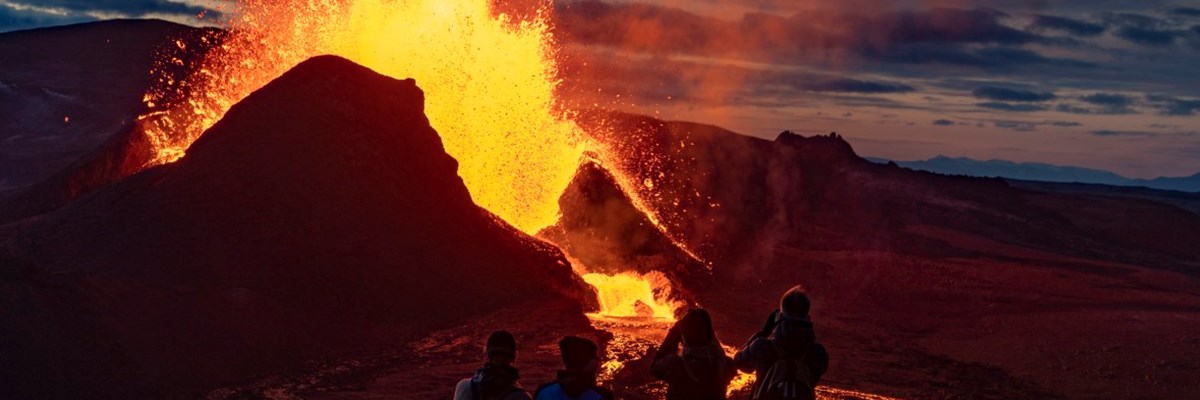
Iceland Volcano 2022: Visiting Iceland’s Volcanic Eruption
As nature puts on a breathtaking display of power, consider enhancing your experience with the convenience and mobility of our reliable Iceland camper van rentals. These well-equipped campervans not only provide a comfortable base for your volcanic adventure but also offer the freedom to chase the eruption's ever-changing vantage points. Dive into the details of our guide for insights on safely navigating the volcanic sites and making the most of this unique natural phenomenon. With Iceland camper van rentals, you can immerse yourself in the wonder of the volcanic eruption, exploring the surrounding landscapes with the flexibility that only a mobile home can offer.
On March 19, 2021, after weeks of rumbling earthquakes around southwest Iceland, the Geldingadalir eruption began. This marked the first volcanic eruption on the Reykjanes Peninsula since the Middle Ages, 800 years ago, and a once-in-a-lifetime opportunity for visitors to see a real-life lava flow changing the face of the country.
Iceland is, after all, the land of fire and ice; and it’s finally lived up to its name again with this new attraction. The Fagradalsfjall eruption began slowly, with lava seeping out of a fissure in the earth, spreading out through the surrounding valleys Geldingadalir and Meradalir. Since it was a relatively small eruption, with the lava moving slowly, nature lovers in Iceland made the trek out to the volcano to watch it in action.
For almost all of 2021, the volcano changed several times. More fissures opened, and the lava field continued to grow as the amount of lava increased and old lava cooled into rock. At one point there was even a fissure spewing forth lava over 300 meters into the air, a fire geysir that could be seen all the way from Reykjavik.
The Iceland volcanic eruption 2021 was officially declared over on the 20th of December. But as of the 3rd of August 2022, the Iceland volcano has once again come to life, offering travellers the chance to see an active volcano in Iceland and new earth being born.
Below, we’ve rounded up everything you need to know about visiting the new volcano in Iceland, completely updated for the Iceland volcanic eruption of 2022.
Where is the Volcano Erupting in the Country?
The volcano is currently erupting in the Meradalir Valley on the Reykjanes Peninsula, southwest Iceland. This is in the general area of Keflavik International Airport, as well as several of the larger towns in the country such as Grindavík. It’s in the same area as Iceland's 2021 volcanic eruption.
Although it’s in the region of the airport, the volcano is in quite a remote area of the Reykjanes Peninsula, about halfway between the town Grindavík on the coast and the volcanic lake Kleifarvatn. Flights have not been affected from the 2022 volcanic eruption.
Almost the entire area of Reykjanes has been designated a Global Geopark by UNESCO, note for its extensive volcanic landscapes and geothermal activity. The area has had a lot of volcanic activity over the years thanks to the two tectonic plates underneath slowly tearing apart as well as a hot spot in the earth’s mantle.
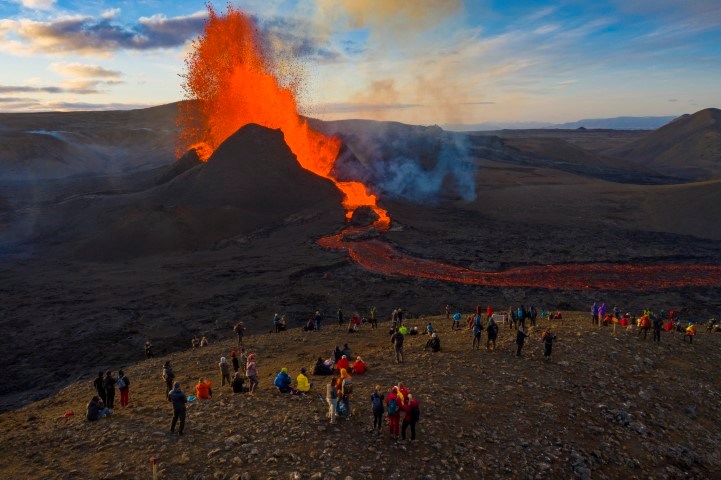
Is Iceland’s New Eruption in the Same Location as the 2021 Volcano?
Although it’s close to the volcanic eruption in Iceland from 2021, it’s not in exactly the same location. The new eruption is further north of Fagradalsfjall volcano in the Meradalir valley, although it’s still a part of the same volcanic system that’s brooding underneath the entire area.
The best part about the eruption’s location is just how accessible it is from Reykjavik. Parking areas have been designated at the trail heads, and the paths to the eruption site of 2021 are in generally good condition. You’ll be able to view the volcanic crater from 2021 as you trek further toward the new eruption.
Preparing to Visit the Volcano
Iceland’s newest volcanic eruption is in a remote location on the Reykjanes Peninsula. The landscapes here are incredible, often compared to a moonscape, shaped by active volcanoes over millennia. From crater rows to lava stacks, it’s a challenging, desolate, area. To make things even more challenging, the new volcanic eruption in 2022 is an even longer hike than the eruption site in 2021. Hikers must come prepared.
The most important thing to do before visiting the Iceland volcano is to check whether the site is open or not. You can do this by looking at the Safe Travel website.
The hike to Iceland’s new eruption site is a minimum of 14km back and forth. The terrain is tough, with slippery patches, large rocks, and steep hills. For most people, the hike will take 4–5 hours.
For such a long hike, you’ll need to be prepared. If you’re ready to check out the volcano live, read on for what you need to bring.
What Equipment Do I Need to Visit the Volcano?
Clothing:
- A sturdy pair of hiking shoes, backed up with soft hiking socks. It’s recommended that your boots are waterproof
- Base layer: wool or synthetic shirt
- Mid Layer: wool, fleece, down, or synthetic top
- Outer layer: something waterproof that breathes well.
- Extra clothes! Layering up or down is the key to beating the changing conditions in Iceland.
- A warm hat
- Mittens
Since it’s a long hike to the volcano, and a once-in-a-lifetime opportunity as well, you’ll likely be spending an entire day out there. As such, you’ll need a few other essentials in your backpack:
- Plenty of food and snacks and lots of water (and a trash bag!)
- First aid kit – just in case.
- Thermos with hot chocolate, tea, or coffee
- Camera
- Hiking poles
- A power bank to charge your gear
- Binoculars
- A fully charged phone
- A GPS unit if you have one.
With this list of gear, you should be ready to begin your trek to the 2022 volcanic eruption in Iceland. But there are a few more points to consider before getting started.
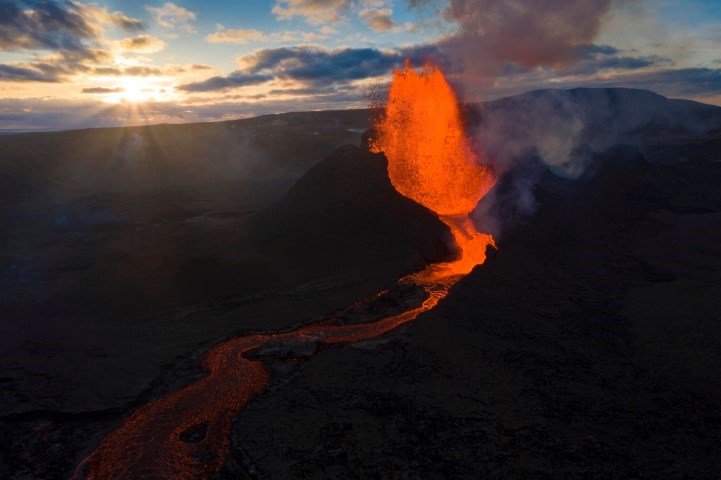
Checking the Weather Forecast
The biggest point to consider when visiting the volcano in Iceland is of course the weather (this is also just a big part of life in Iceland!) Conditions can change in an instant, and since you’ll be out in the middle of what is essentially a barren, volcanic valley, it pays to know what kind of weather you’re in for.
To view the weather forecast for Iceland’s newest volcano, you can use the handy website volcanoweather.is, which covers the Meradalir area. For maps of wind, rainfall, and temperatures to expect, the website of the Icelandic Met Office is the best in the business.
Finally, you can also view if there’s gas in the area using this forecast from the Iceland Met Office. Gas is an important thing to consider if you’re thinking about safety at the eruption site (more on that below).
Parking at the 2022 Icelandic Eruption
You’ve packed your bags, got your gear ready, and are ready to see this live Icelandic eruption. It’s only a short drive from Reykjavik to the trailheads, where several parking areas were already set up thanks to the long eruption of 2021.
The biggest thing to note here is that you will need to pay for parking when arriving at the volcano (currently the cost is 1,000 ISK).. To do so, you will need to download the app Parka.is and pay online. Download it here for iOS or for Android.
To see a map of where you can park at the eruption site, check it out below. It’s also important to note that parking along the roads or anywhere else but the designated parking areas could land you with a hefty fine.
How Do I Get to the Volcano?
The Iceland Volcano Hike
Getting to the volcano requires a long hike through rough terrain on the Reykjanes Peninsula. The trails to Fagradalsfjall volcano eruption site are in somewhat good condition, but beyond that, the terrain gets very difficult. Just before you reach the new eruption site, you will have to scramble up some steep hills.
The hike to the eruption site is 7km one way (approximately 4.5 miles) with an incline of around 300 meters (0.2 miles). That makes this a 14km (9 miles) return hike.
For most people, this means a total hiking time of around 4.5–5 hours.
Below you can find the latest map of the area to get an idea of where you can park your car and what trail to take. To get to the new eruption, it is best to park your campervan in parking lot #1 (to the left). You can then easily access Path A. On this trail, it’s about 5km before you can see the 2021 eruption crater, and a further 2km from here to the new eruption site in the valley Meradalir.
Please note! The eruption site will continually evolve, and this map may become out of date at some point. We’ll do our best to update any information as it comes in.
You can also see that there is an alternative Path B that branches off Path A and loops around. This was created as an alternative route to the Fagradalsfjall volcano but is rarely used today. The trail is much more difficult, but can be used as a backup in case the wind is blowing poisonous gases over Path A.
Path C is another path from the 2021 volcanic eruption. It offers you fantastic views of the newly created lava field and the volcanic crater, and a distant view of the new volcano
Safety at the Volcano
It goes without saying that volcanoes aren’t to be trifled with – it’s important to stay safe when visiting. Gas pollution is the biggest problem – currently, the ICE-SAR team are on site every day measuring the levels for safety. If the volcanic eruption is closed due to high gas levels, it will be published on the Safe Travel website as well as the local news and across Icelandic social media channels.
What Are the Dangers of Visiting the Iceland Volcano Eruption 2022?
It’s important to keep in mind that while spectacular, visiting the volcanic eruption site in Iceland does come with some risks. The potential dangers of visiting Iceland’s newest volcano are as follows:
- The Risk of Gas Pollution: The volcano in Iceland is not just spewing forth lava, but also poisonous gases. The volunteers from the ICE-SAR team are on site monitoring the levels. It’s important to note that the gases can pool in low-lying areas which can be lethal.
- New Volcanic Fissures: There’s no telling what might happen at the site of Iceland’s volcano. New fissures could open without any notice.
- Lava Flows: While pretty, the lava flow can quickly change direction if it bridges a wall or spills over the side of a cliff. In this case, it is very hard to run away from it.
- The 2021 Lava Field: On the way to the new volcanic eruption site, you’ll pass the Icelandic volcanic crater from 2021’s eruption. While it may look hard, walking on the newly formed lava is still strictly forbidden. The crust is thin and there’s hot lava beneath.
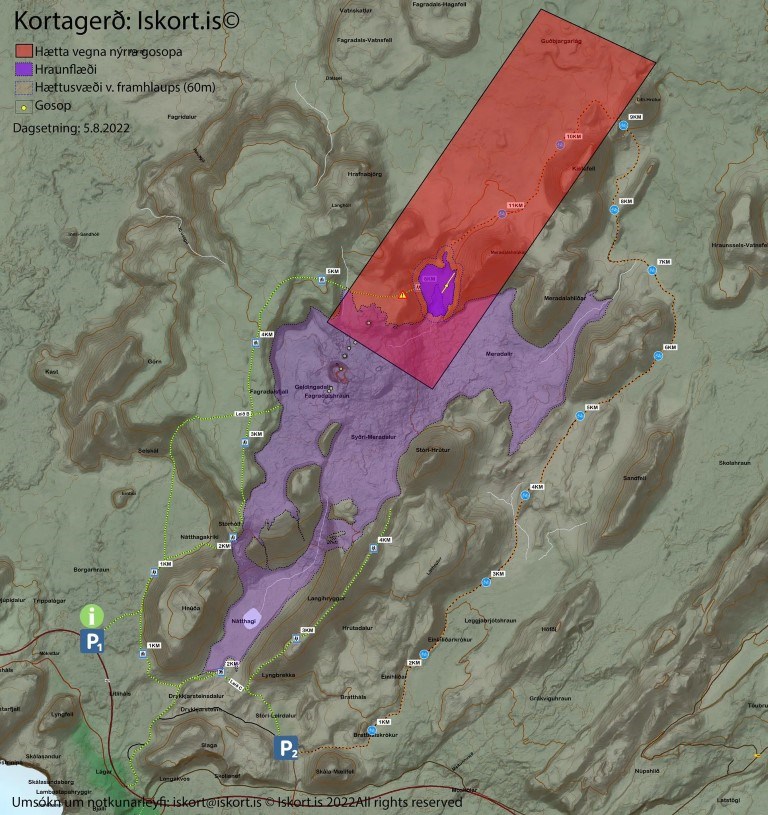
In this map, the area shaded in red is where new fissures may open. The purple is the lava field from the 2021 eruption.
Staying Safe at the Volcano
- Children under the age of 12 are not allowed on the eruption site or the hiking trail to the eruption.
- Stay on the hills and ridges around the volcano. If there’s gas in the area, it tends to gather in the lower valleys.
- The volcanic gas is not visible and can’t be detected by smell either. Pollution can increase rapidly in the area, so if you start to feel any discomfort you should leave immediately.
- There are police and ICE-SAR members on site. Talk to them for any information, and always follow their instructions.
- Phone reception in the area is very poor, so make sure you’re fully charged before you set out (and bring a power bank).
- Before you set out on the hike, make sure to log your plans with Safe Travel.
- Bring food and water with you.
- Make sure to keep tabs on the weather!
How Long Will the Eruption in Iceland Last?
It has been less than a year since the Fagradalsfjall volcano stopped erupting at the end of 2021. Now that another eruption has already begun, volcanologists around the world are speculating that this is the beginning of decades of volcanic activity in the Reykjanes Peninsula. The volcanoes of Iceland seem to be waking up.
As of writing, it’s still unclear for how long this new eruption will continue; scientists still need more time to monitor the volcanic activity in the area.
Like its predecessor, the new Icelandic volcano is unlikely to pose any risk to human populations in the area. The lava flows are currently creeping their way through uninhabited valleys.
Reports say that the lava flows are much stronger than the previous eruption, which could either mean it sputters out much faster than the eruption in 2021, or the lava flows much further, possibly even threatening the main road along the south coast of the Reykjanes Peninsula.
Has the volcano eruption finished? Listen to what the specialists have to say.
Photographing the Volcano
Unlike those pesky northern lights, photographing the Iceland volcano eruption 2022 is quite easy – any old camera phone should produce some stunning shots for you to take home with you.
Professional photographers will want to take a drone to the eruption site, which will produce the most spectacular shots. However, there are some rules to follow if you’re going to do this.
Drone Restrictions at the Iceland Volcano Eruption 2022
If you’re planning on flying your drone over the 2022 eruption in Iceland, please take note of the following rules given out by the Icelandic Transport Authority.
- Your drone must be marked with your name, phone number, and address
- It’s prohibited to fly your drone higher than 120 metres above the ground
- Flying your drone over a crowd of people is prohibited
- Your drone must always remain in your line of sight
- Always be mindful of flying your drone near other drones or manned aircraft
- Drone operators are responsible for any damage that may result from its use
Follow these rules and you’ll return with some spectacular shots of the volcano and lava flow!
Can You See the Volcano from Reykjavik?
At first, the volcanic eruption in Iceland could be seen from Reykjavik only as an orange glow behind the mountains.
Then, in May of 2021, the eruption has turned into a sort of geysir, spurting lava 300 metres into the air. From the capital, it was easily visible.
Now the 2022 eruption is beginning – currently, it can only be seen again as a faint orange glow in the evenings, or smoke rising into the air on a clear day.
The eruption is continuing to change and evolve, every week bringing something new to marvel at. Nobody is quite sure what will happen! That’s the beauty (and frightening part) of Icelandic volcanoes.
Volcanic Activity in Iceland
Iceland, situated on the Mid-Atlantic Ridge, is a country with a lot of volcanic activity and geothermal energy, which is one of the biggest reasons behind the country’s popularity. A relatively young country compared to others, the landscapes here offer a chance to see the world as it was millions of years ago – ancient in our eyes, yet young in the eyes of the Earth.
People visit Iceland to see these fantastical landscapes, playing out in lava fields and waterfalls, epic glaciers and steep mountains, peaceful fjords, and violently scarred volcanic craters. There are several volcanic systems beneath the country that have produced the spectacular landscapes you see today. Active volcanoes have erupted ever since Icelanders landed on the shores, and life in Iceland is defined by its nature – for over 1,000 years, Icelanders have learned to live in the shadow of not just volcanoes, but constant threat of glacial flooding, avalanches, and earthquakes.
All this geological activity in Iceland is thanks to a couple of things. The first is the fact that Iceland is situated right on top of two tectonic plates. One part of the country is on the North American plate, the other on the Eurasian plate. These two tectonic plates are slowly inching apart year by year, which causes a lot of earthquakes and other geothermal activity, helping shape the dramatic country.
On top of that, Iceland is also situated on top of a hot spot in the earth’s mantle. This feeds lava from the earth’s core into the volcanic systems beneath the country, creating a perfect storm of volcanic activity above when combined with the geological activity caused by the tectonic plates moving.
Read: 6 More Volcano-Themed Activities to do in Iceland
Go BackRelated articles
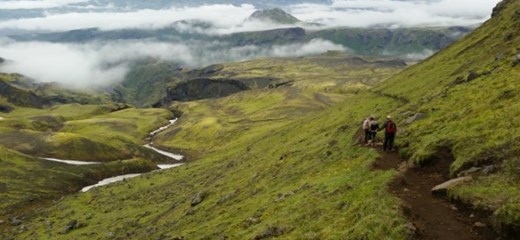
Hiking Fimmvörðuháls With a Campervan
Discover how you can hike the famous Fimmvörðuháls Pass in South Iceland if you've rented a campervan.
Read more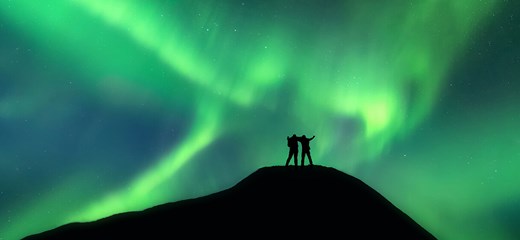
The 10 Best Places to See the Northern Lights in Iceland
The northern lights in Iceland appear everywhere, but some locations are a little bit more magical than others. Find out where inside.
Read more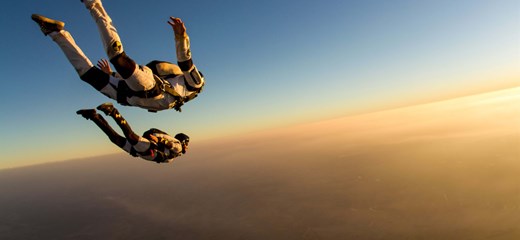
The Best Extreme Adventure Activities in Iceland
Extreme adventure activities in Iceland are unlike anywhere else. Diving, snowmobiling, ice-climbing, and white-water rafting is just a small dose of what’s available.
Read more James Taylor
James Taylor






